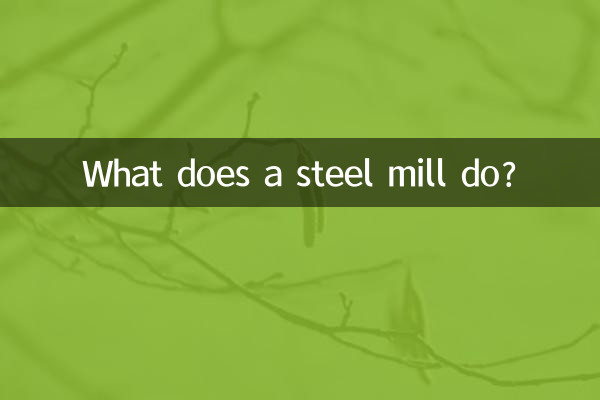What does a steel mill do?
In industrial production, steel is an indispensable basic material, and steel plants are the core places for steel production. Whether in construction, automobile manufacturing, machining or daily necessities, steel plays an important role. This article will introduce in detail the functions, production processes and recent hot topics of steel plants to help readers gain a more comprehensive understanding of this industry.
1. Main functions of steel plants

The core mission of a steel mill is toProcess iron ore or other raw materials into various steel products. Specifically, the main functions of a steel plant include:
| Functional Category | Specific content |
|---|---|
| Ironmaking | Converting iron ore into pig iron through blast furnace or direct reduction process |
| steelmaking | The pig iron is further smelted to remove impurities and adjust the composition to obtain molten steel. |
| rolled steel | The molten steel is cast into steel billets and then processed into plates, profiles, etc. through the rolling process. |
| Deep processing | Surface treatment, cutting, welding, etc. of steel products to meet customer needs |
2. Production process of steel mill
The production of steel plants is a complex and precise process, which is mainly divided into the following stages:
| production stage | key equipment | output |
|---|---|---|
| Raw material preparation | Raw material yard, sintering machine | Sinter, pellets |
| Ironmaking | Blast furnace, direct reduction equipment | pig iron |
| steelmaking | Converter, electric furnace | molten steel |
| Continuous casting | Continuous casting machine | billet |
| rolled steel | Hot rolling mill, cold rolling mill | All kinds of steel |
3. Recent hot topics in the steel industry
According to the data monitoring of the entire network in the past 10 days, the hot topics in the steel industry are mainly concentrated in the following aspects:
| hot topics | Main content | Attention |
|---|---|---|
| carbon neutrality goal | Many steel mills have announced carbon emission reduction roadmaps and are exploring new technologies such as hydrogen energy steelmaking. | high |
| Steel price fluctuations | Affected by the cost of raw materials, the prices of some steel products have rebounded | middle |
| Smart manufacturing | The application cases of 5G and AI technology in steel plants are increasing to improve production efficiency | high |
| Export policy adjustments | Some countries adjust steel import tariffs, affecting my country's exports | middle |
4. Future development trends of steel plants
With the improvement of environmental protection requirements and technological advancement, steel mills are developing in the following directions:
1.Green production: Reduce carbon emissions by using electric furnace steelmaking and scrap steel recycling.
2.Intelligent upgrade: Utilize big data, Internet of Things and other technologies to achieve precise control of the production process.
3.Product high-end: Develop special performance steel to meet the needs of new energy vehicles, wind power and other emerging industries.
4.Industrial chain integration: Strengthen cooperation with upstream and downstream enterprises to form a more complete industrial ecology.
5. Key data of the steel industry
Here are some important recent steel industry statistics:
| Indicator name | numerical value | Year-on-year change |
|---|---|---|
| Average daily output of crude steel | 2.8 million tons | +3.2% |
| Steel social inventory | 15 million tons | -5.8% |
| Average price of iron ore imports | 120 USD/ton | +8.6% |
| Industry profit margin | 4.5% | -1.2% |
To sum up, as the infrastructure of modern industry, steel plants not only bear the important task of producing various steel products, but are also constantly adapting to new development requirements. Through technological innovation and industrial upgrading, steel mills will play an even more important role in the future.

check the details

check the details